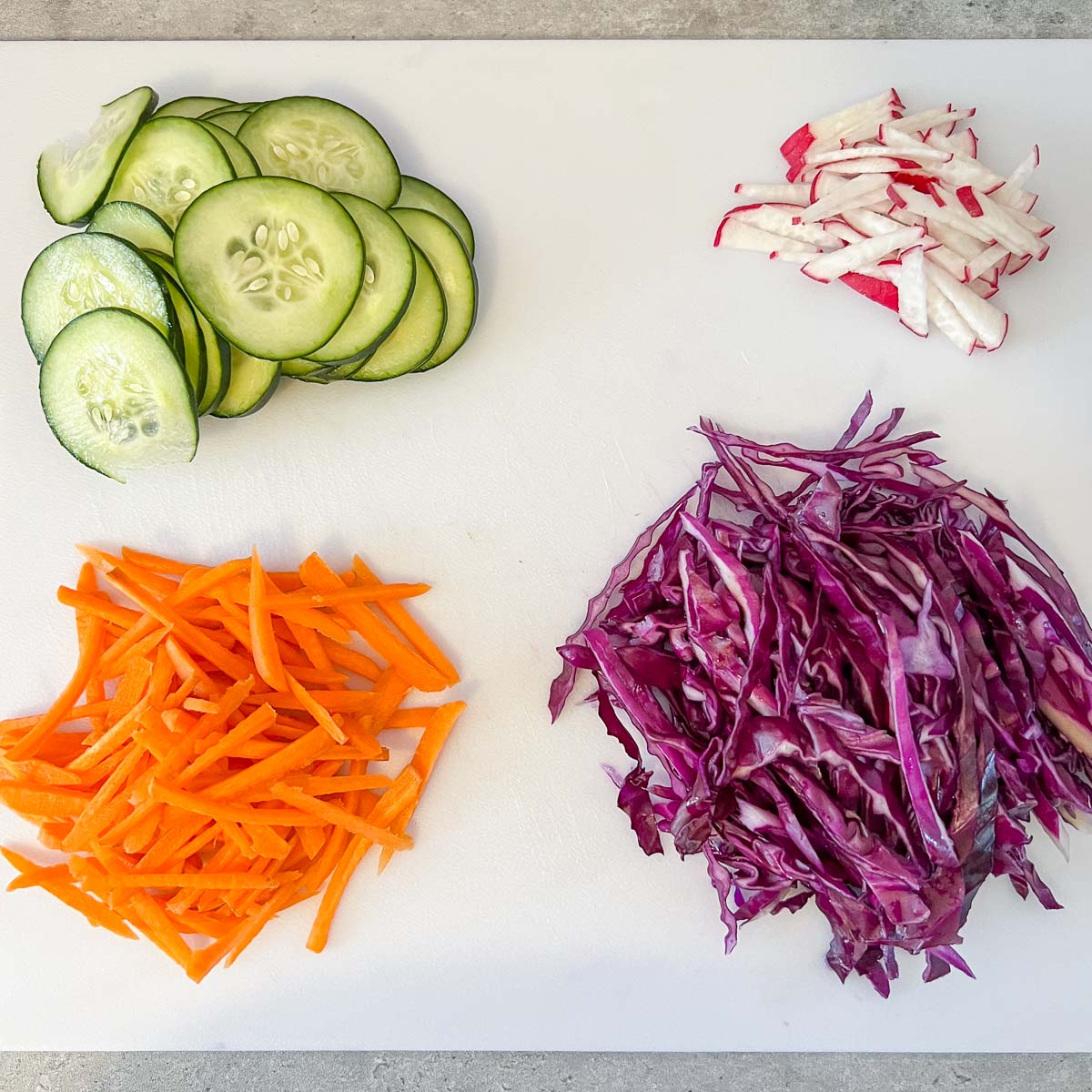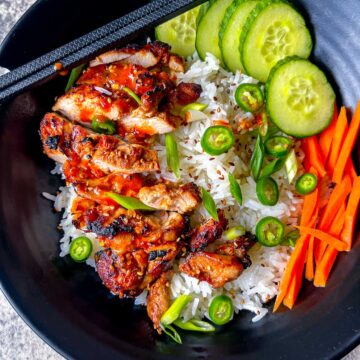These gluten-free soba noodles are the perfect quick meal if you're looking for something light and delicious with a spicy twist! This dish draws inspiration from both refreshing cold Japanese noodle salads and the heat of Korean spicy noodle dishes. If you liked my article about vegan Asian noodles, you'll definitely want to give this recipe a try!

I recently saw a viral recipe on TikTok for gluten-free ramen and it reminded me of one of my personal recipes that I hadn't made in a while!
I was inspired by both Korean and Japanese foods for this recipe, and I think the two pair very well together in this case. Soba noodles are a staple of Japanese cuisine and are made from buckwheat flour, rather than wheat flour. Buckwheat soba noodles are a great option for anyone trying to keep to a gluten-free diet.
One of my best friends has celiac disease, so when she comes to visit me every year I try to come up with dishes we can both enjoy.
Buckwheat noodles are one of the things I like to keep on hand because they can be used in so many dishes! They can be used in stir-fries, broths, and, my personal favorite, soba noodle salads like this one!
Pro tip: Even though soba noodles are genuinely gluten-free, always check the ingredients list! There can be some variation between brands, and you also want to make sure they weren't processed in a facility that processes wheat.
Jump to:
😍 Why You'll Love This Recipe
- These cold Japanese noodles with a spicy Korean twist are so quick and easy to make!
- This dish is made with gluten-free noodles, making it a super tasty option for anyone who is gluten-intolerant.
- The cooking process for this recipe is very minimal, so it's a great recipe to start with if you're new to cooking!
- Soba noodles are a great source of B vitamins and contain all 8 essential amino acids. Some even claim that they can lower your blood sugar and cholesterol and aid in the prevention of heart disease.
🛒 What You Need To For This Recipe

🔖 Recipe Ingredients and Substitutions
- Soba noodles: Glass noodles would be another great option for this dish, as they are also gluten-free.
- Radish: Daikon radish would have been ideal, but I was fresh out. If you're not a radish fan, this can be left out or replaced with your favorite vegetable.
- Red cabbage: Napa cabbage is a great alternative, but really, any cabbage will do!
- Toasted sesame oil: Make sure you're using the toasted kind! If you're unsure, check the color. Toasted sesame oil will be brownish in color, whereas regular sesame oil is more of a yellowish-gold.
- Mirin: Rice vinegar is also fine to use.
- Minced garlic: I use jarred minced garlic, but fresh garlic is preferable. Garlic powder will also do.
- Brown sugar: Granulated sugar is also okay.
- Fine Gochugaru: This is a Korean chili powder, and is totally optional. I like it because it adds some extra heat, but it's already a spicy dish so if you think it might be too much you can leave it out. It can be substituted with Cayenne pepper, although I would start with ½ the amount listed in this recipe and adjust to taste.
- Kimchi juice: This adds a little more acidity to the sauce, but feel free to leave it out. I only had a few pieces of kimchi left in the jar, so I tossed those in as well, which added a little extra flavor and crunch.
- Sesame seeds: I used both regular and black sesame seeds, either of which will work.
- Nori: AKA dried seaweed. I used the nori to garnish the dish, but this is optional.
🍲 How To Make Gluten-Free Soba Noodles
Step 1: Combine soy sauce, gochujang paste, gochugaru powder, brown sugar, vinegar, garlic, sesame oil, Mirin, and kimchi juice (optional) in a bowl and mix to combine.


Step 2: Slice cucumber, shred cabbage, and julienne carrots and radishes. Place the sauce and veggies in the fridge until needed or leave them out if you prefer to eat your food closer to room temperature.

Step 3: Cook soba noodles according to instructions on the package.

Would you like to save this recipe?
Pro tip: I recently learned a helpful trick for cooking the perfect soba noodles every time! Place the noodles in once the water comes to a boil, and leave them in until the pot starts to froth over. Toss in a couple ice cubes and wait until the pot froths over again. Pull the noodles out at that point and they should be the perfect al dente texture.



Step 4: Place the noodles in a colander and rinse with cold water until the noodles have cooled off.

Step 5: Toss noodles, veggies, and sauce together and garnish with sliced nori and sesame seeds.

If you enjoy Asian noodle dishes, make sure you try this yummy yakisoba with chicken!
🥢 Recipe Variations
The noodle dish I made is both gluten-free and vegan/vegetarian, but if you'd like to add some protein, some thinly sliced beef, chicken, or a hardboiled egg would make great additions.
Glass noodles would also be a great base for these spicy Korean/Japanese cold noodles. Glass noodles are gluten-free, although less nutritious than soba. I wrote a whole guide to Asian noodles that you can read for more info.
I give you full permission to be creative with the veggies you include. Personally, I would have thrown in some shiitake or enoki mushrooms if I had any on hand. Some other great options would be onions, red bell pepper, spinach, bok choi, kimchi, etc!
Looking for other Asian noodle recipes? Be sure to check out this yummy Lo Mein Noodles recipe from Cindy at BeBraveAndBloom.com!
🤷🏻♀️ Recipe FAQs
Soba noodles have been a crucial element of Japanese cuisine for centuries and were often served to Zen Buddhist monks before fasts or long periods of meditation. Soba noodles are traditionally made with buckwheat and water, meaning they are naturally gluten-free! You should always check the label to make sure the noodles you're buying weren't processed in a facility that processes wheat, but soba noodles are typically safe to eat if you have a gluten intolerance.
Soba noodles are traditionally made completely gluten-free (however, you should always check the label because there can be some variation between brands). Udon noodles, another Japanese favorite, are made with wheat flour so unfortunately, they are not gluten-free.
Yakisoba is a very popular Japanese dish that literally means "grilled noodles". Yakisoba is most commonly made with wheat flour noodles similar to ramen noodles, which, unfortunately, are not gluten-free. If you're making Yakisoba at home, a great gluten-free noodle alternative would be soba (buckwheat) noodles. Soba noodles are made gluten-free using buckwheat flour instead of wheat flour.
Soba noodles are probably the most common gluten-free noodle option in Japanese cuisine, but you can also find Japanese glass noodles (harusame) and starch noodles (shirataki). Avoid ramen, udon, somen, and hiyamugi noodles as these all contain wheat flour.
👩🏻🍳 Pro Tips
- I like my veggies fresh because I love the crunch they add to the dish! However, you can sauté the carrots, cabbage, and radish if you prefer them a little softer.
- Make sure you allow the noodles to cool completely while running them under cold water so they don't continue to cook.
- I don't recommend storing this dish for longer than a day.

🍜 More Asian Recipes
Did you make this recipe?
📖 Recipe

Gluten-Free Soba Noodles Recipe
Ingredients
Method
- Combine soy sauce, gochujang paste, gochugaru powder, brown sugar, vinegar, garlic, sesame oil, Mirin, and kimchi juice (optional) in a bowl and mix to combine.
- Slice cucumber, shred cabbage, and julienne carrots and radishes. Place the sauce and veggies in the fridge until needed or leave them out if you prefer to eat your food closer to room temperature.
- Cook gluten-free soba noodles according to instructions on the package.
- Place the noodles in a colander and rinse with cold water until the noodles have cooled off.
- Toss noodles, veggies, and sauce together and garnish with nori and sesame seeds.
Nutrition
Notes
- Even though soba noodles are genuinely gluten-free, always check the ingredients list! There can be some variation between brands, and you also want to make sure they weren't processed in a facility that processes wheat.
- I recently learned a helpful trick for cooking the perfect soba noodles every time! Add the noodles in once the water comes to a boil, and leave them in until the pot starts to froth over. Toss in a couple ice cubes and wait until the pot froths over again. Pull the noodles out at that point and they should be the perfect al dente texture!
- I like my veggies fresh because I love the crunch they add to the dish! However, you can sauté the carrots, cabbage, and radish if you prefer them a little softer.
- Make sure you allow the noodles to cool completely while running them under cold water so they don't continue to cook.
- I don't recommend storing this dish for longer than a day.






Keena says
This is a very, very good recipe. Or was truly delicious, and perfectly balanced on all parts. I’ll definitely make it again!
Hilda Sterner says
Thanks Keena, so happy to hear it. We appreciate the review! Enjoy!!